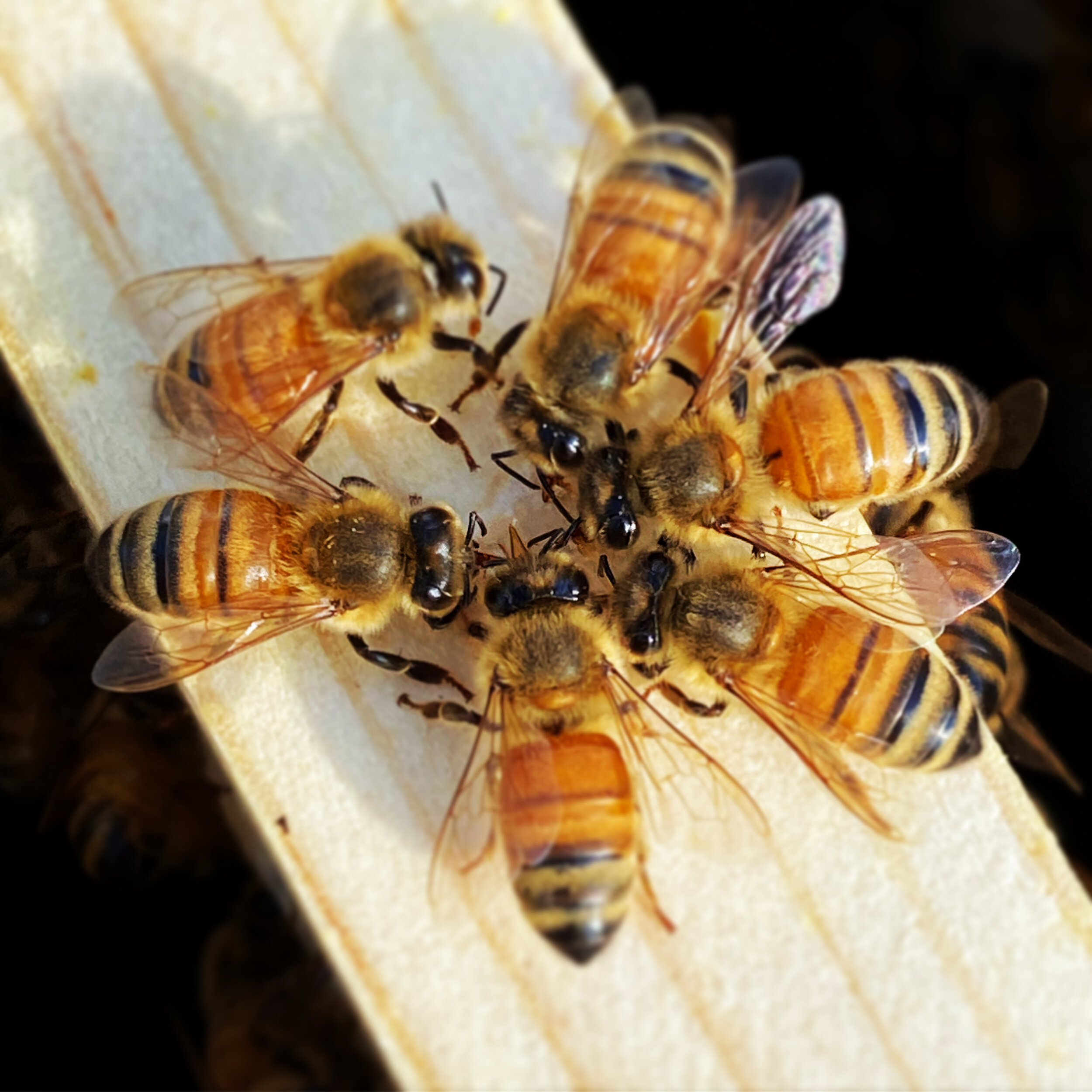OUR HONEYBEES.
Our Hives.
Our apiary began with two beehives near our fruit trees. In our second year, we added two additional beehives because of our love for honeybees and beekeeping! We have the hives setup in an east-facing location to help the bees wake with the early morning sun! The earlier they can start flying, the more nectar they can collect and honey they’ll make! The bees fill the two bottom, deep hive boxes with honey for their winter food supply and we only harvest the excess honey from the medium-sized boxes on top.
Our Original 4 Hives
Our Bees.
Our honeybees are an Italian subspecies of the western honeybee. They are known to be gentle, very productive, less inclined to swarm, resistant to disease and strong comb builders. Our bees are treated with a safe, organic varroa mite treatment to ensure they head into the winter healthy and mite-free! We believe in helping save the honeybees, as they are vital pollinators to our environment. Hence, why we donate 10% of every honey jar sale to support local pollinator protection efforts!
A Circle of Strong Women
Our Honey.
Our area is surrounded with beautiful red clover in the spring, wild flowers, and fruit trees for our bees to produce a delicious sweet, thick honey! Our honey is always raw and unfiltered! During harvest, we do gently strain the honey to remove any bee parts and large chunks of wax. We never heat our honey during our bottling process as we want to maintain its nutritious content. Our honey has zero additives such as corn syrup or honey imitation flavors. It’s 100% pure honey from our amazing bees!
“The world is plentiful with honey, but only the humble bee can collect it.”
— Ralph Waldo Emerson
HONEY AND ITS USES.
For thousands of years, honey has been harvested and used by humans for its many benefits. Honey is full of vitamins, minerals, antioxidants, amino acids, and has anti-inflammatory properties.
We’re often asked, “What is honey?” Honey is simply flower nectar without its moisture content. When the honey bee arrives at a flower, the bee sucks out and stores the floral nectar in its second stomach called a “honey stomach”. Back at the hive, the foraging bee regurgitates the nectar into the mouth of an indoor “nectar processing” worker bee. The receiving worker bee lowers the nectar’s moisture content from about 70% to 20% by repeatedly storing the nectar and regurgitating it onto the tip of her tongue. The bee then stores the honey in a honey comb cell. The nectar will lose additional moisture while the cell is uncapped. Once the moisture content reaches about 17%, the worker bees will cap the cell with beeswax.
Wound Treatment.
“Topical use of medical-grade honey has been shown to promote wound healing, particularly in burns.”
Source: Mayo Clinic
Baking Alternative.
For any recipe calling for processed sugar, try substituting the sugar with honey. “Raw” honey is a healthier and nutritious sweetener without the crash!
In fact, if you ever need a little energy boost during the day try eating a honey stick.
Allergies.
Using “raw” and “unfiltered” honey from your local area may help combat allergies as the pollen (an allergen) will not be filtered out during the harvest process. “A small dose of repetitive exposure to your local allergens is one method of allergy treatment.”
Source: Mayo Clinic
Cough Suppressant.
“Studies suggest that eucalyptus honey or citrus honey can act as a reliable cough suppressant for some people with upper respiratory infections and acute nighttime cough.”
Source: Mayo Clinic
*WARNING* Honey should never be given to an infant younger than one.
FUN FACTS.
The Queen.
The Queen bee is noticeably larger and longer in size than a worker honey bee. She will spend the majority of her life inside the hive laying thousands of eggs per day. She will never visit a flower or make honey.
Crystallization.
Depending on the flower nectar sources used by the bees, some honey may crystallize faster than others. Simply place your honey in a bowl of warm water to enjoy a smooth, drizzle-worthy honey again!
Hive Population.
Each hive has one queen bee, worker bees (female bees), and drone bees (male bees). A healthy colony could reach a population size of about 60,000 bees during the late spring or early summer.
Let’s Dance.
Did you know honeybees have a dance move called the ‘waggle dance’? They waggle in a figure-eight loop to communicate to their hive mates a nectar source’s location. The longer the dance, the further the distance to the flower. The angle of the dance corresponds to the angle from the sun the bees should take when they leave the hive.
None of Your Beeswax.
Young worker bees have 8 wax glands at the end of their abdomens. The bee can produce paper-thin scales of wax. The scales are transferred to their mouth, where they knead them together in a workable wax putty to build comb or to cap honey cells.
Flight of the Bees.
Honeybees can travel 3-5 miles from their hive’s location and can visit anywhere from 50-100 flowers during a collection flight. A bee will carry close to her own body weight in nectar and pollen back to the hive. Can you imagine carrying close to your own body weight for 3-5 miles?
No Expiration Date.
If you keep your honey in a cool location, away from the sunlight, and in a tightly sealed container, then your honey could last for centuries!
Winter Clusters.
The hive must have a large population of healthy, young bees going into the winter. Honeybees do not hibernate, but they do cluster in a tiny ball to generate heat to keep the queen and themselves warm during our cold Colorado winters.
“A day without a friend is like a pot without a single drop of honey inside.”
— Winnie the Pooh








